THE BACKLOT
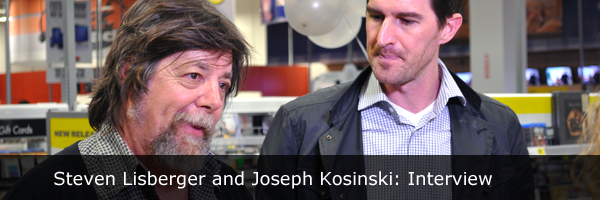
By William Kallay
The image is surreal. Jeff
Bridges reprises his classic role as
computer hacker, Kevin Flynn. He is telling his young son, Sam
(Owen Best), about the Grid. His son listens intently. The
audience does not see Flynn's face too much, but he certainly
looks youthful. However, Bridges is not really in his thirties
anymore. He is in his sixties now. It is a new century. Has
Bridges stepped into a time machine? In a way, he has. Along
with him is the original writer/director of Tron,
Steven Lisberger. Via modern digital visual effects, Bridges has
been made to look young again.
Tron: Legacy brought back Kevin Flynn to the big
screen. It also brought back the mythology created in the 1982
cult classic,Tron. The 2010 film won mixed reviews from
critics, but went on to earn nearly $400 million in worldwide
box office receipts. It has spawned an animated television
series on Disney XD and a rumored sequel. The long-lasting
appeal of Tron has certainly surprised many people, for
the original film was thought to have been a financial
disappointment. In reality, the film made a profit, spawned
computerized visual effects and animation, jumpstarted a
moribund Disney studio, and changed how we see films today.
Lisberger kept faith in the ideas of Tron. He
envisioned cyberspace as a frontier of extraordinary
possibilities. "Programs" took human ("Users") instructions and
tried to make their own world a better place, even in the face
of a corrupt Master Control Program. Unfortunately, the computer
frontier became corrupt with viruses, slander, and naughty
things. Not quite what the world Lisberger envisioned.
Nonetheless, Lisberger was persistent and Tron: Legacy
was made with updated ideas.
I spoke with Steven Lisberger, who wrote and directed the original film, and Joseph Kosinski, who directed the second film. For Lisberger, it was almost like going home for the first time in years. The landscape and technology ushered in by Tron was a lot different. Many of the people who worked on Tron: Legacy were either small children or had not been born when Tron was released. Lisberger was home again. For Kosinski, a high-profile commercial director, it was an opportunity to refresh the world of Tron.
I met Lisberger and Kosinski during the
release of Tron: Legacy and Tron on Blu-ray
and DVD. The public was able to meet both directors during this
autograph signing event on April 5, 2011 at the Best Buy in West
Hollywood, California.
Photo gallery below.
FSTDVD KALLAY:
What was it like for you to step back on to the Game Grid?
STEVEN LISBERGER: I had mixed feelings. One strange sensation is the opposite of what you would think—in that you’re standing there with Jeff (Bridges) and you’re on a Tron set and he’s wearing a Tron costume. And suddenly it’s like, “Wow! All the years in-between disappeared. Why do we both look as old as we look?" My son Carl wasn’t born when Tron came out. Joe [Kosinski] was whatever he was, seven years old. You started hearing the ages of people working on the film in relationship to when the first film came out. Then you realize a whole generation has grown up in those years.
KALLAY: It was a reunion with Jeff Bridges and Bruce Boxleitner being on the set.
LISBERGER: It was sweet. It was under such happy terms to come back together for this was a great way to do it. Jeff hasn’t changed. Still as flamboyant as ever.
KALLAY: Do you recall what
it was like for him to step back into the Tron world?
LISBERGER: I know that Jeff is freaked about
the technology. He worries about his cyber alter ego. The funny
thing is that although he plays this computer genius in the
film, he’s really a low tech kind of guy in real life. He spends
more time worried about technology than he does, I think,
actually using it. But he likes the fact that Tron
provides an arena for him to be so far out.
KALLAY: It’s kind of like him playing a kid again.
LISBERGER: That’s one of the strange things about the first Tron compared to the second. Even though we have way more technology this time, we built so much more in front of the camera. When we did the first film, it was just an empty stage and it really felt sort of Shakespearian. You’re wearing your gladiatorial costume. You’re standing under a spotlight on an all black empty stage, and you might as well be doing Hamlet. But on this one, Joe built everything. You really were in that nightclub or in Flynn’s safe house. It was really like you were there. We didn’t cheat about anything. Even the fabric was picked out perfectly on every couch and every pillow. You have to remember all the costumes were totally practical. They actually glowed.
KALLAY: The original film was shot in 65mm. That footage went through different stages to get the Tron look. VistaVision, Kodaliths and Technirama formats were used. The sequel was filmed in digital 3-D. What were some of the challenges that you recall with that new format?
LISBERGER: It’s funny because there were so many times on Tron: Legacy where you think you could take the new technology that exists and it would make things a hundred times easier than on the first film. But damn if we didn’t figure out a way to make it just as hard in every category. [On the original film] we had these enormous 70mm cameras. They were the size of dishwashers. The new cameras are this big (mimics small camera size). But nope. We shot it in 3-D with a beam-splitter and a rig that holds the two cameras. And we ended up with a giant, huge metal box that was about as big as our 70mm camera! So it went right back to let’s make this as hard as we can. The same happened with the CGI computer capability. One frame of the Light Cycles in Tron: Legacy has more computer processing in it than all of the frames in Tron. You could do the whole movie probably in a week in terms of the computers. We rezzed up every centimeter of that “Electronic World” to the point where we barely got it done in eighteen months.
KALLAY: In a way it was the same as using Kodaliths. There were truckloads of Kodaliths on the Disney studio lot in 1981. They were needed just to handle the amount of Kodaliths coming back from the Cuckoo's Nest in Taiwan. On Tron: Legacy, the amount of computer data is just crazy.
LISBERGER: It’s true. I didn’t even think of that. There was all of this physical storage of the handmade film, and then there was all this cyber/digital storage of this one (Tron: Legacy).
KALLAY: Both you and Joseph
come from extensive artistic and architectural backgrounds. Did
you collaborate on storyboards or animation?
LISBERGER: Joe came in from a completely
different place. I went to film school. Joe studied as an
architect. In a way, I think, Joe approaches it a little more
like he’s a natural. He studied architecture and he had his
style. He moved that whole style into film. He’s more of an
individual. I was more of a team kind of studio guy. I had my
own little studio. I like that ensemble feeling. We were all
involved from the beginning. That’s not really the contemporary
approach. Joe worked with Digital Domain, so they were a part of
this team. He’s more of a contemporary director.
[Joseph Kosinski arrives after being stuck in Los Angeles traffic. Greetings are exchanged and Kosinski joins the conversation.]
KALLAY (to Kosinski): I love the opening of Tron: Legacy in which the audience sees Sam Flynn's bedroom. There are posters on the wall for The Black Hole (1979) and Tron. When you were growing up, were you into Disney films?
KOSINSKI: We were trying to populate a 1988/1989 bedroom of a seven year old kid, which is younger than I was at the time. I remember seeing Tron. I had the Tron yo-yo. I remember The Black Hole. I had The Black Hole record and the board games. All that stuff. So that was all selected on purpose. We’re working on a script for The Black Hole [remake]. Why not throw it in there? [to Lisberger] I’m curious. Was there any relationship between Maximillan the robot and the Recognizers in Tron?
LISBERGER: No.
KOSINSKI: You based the Recognizer on something. Was it a computer part?
LISBERGER: Yeah. I don’t remember if I showed you this, but we had the Computer Dictionary. It was a paperback book. I think it’s fifteen pages with eight entries on each page. The word avatar isn’t in there.
KOSINSKI: Bits and bytes are in there.
LISBERGER: Yeah, bit and byte are in there. I would go through and I would look for words and hope they were called something that was provocative because they were provocative that way.
KOSINSKI: I did the same thing. A rectifier is a piece of a computer. It’s a transistor that rectifies a current and makes it pure.
LISBERGER: I looked it up. The Recognizer was some term, I forget what it was. That basic design really never changed. [John] Norton did that very early on and nobody wanted to take it on.
KOSINSKI: It’s iconic.
LISBERGER: Syd Mead and Moebius looked at it and said, “I’m not doing it. It’s fine! Leave it alone.”
KALLAY: It’s a very striking character in both films.
LISBERGER: For me it’s sort of the front half of a gorilla.
KOSINSKI: Yeah, it’s the
face.
LISBERGER: That head and that mass. It was sort
of a cyber King Kong.
KALLAY: Was it a challenge for you to remain faithful to Steven’s original vision, as well as yours in bringing Tron: Legacy to the big screen?
KOSINSKI: I never thought of it as a challenge. I thought of it as this incredible soup of great ideas and designs that was an amazing starting point. Steven pointed out to me that the Light Cycles in the original Tron movie were not exactly how he really intended them to be. That kind of canopy that they ended up having to put on the top. The enclosed bike was not the initial sketch that Syd Mead did and Steven wanted to do. Because of the technology, they had to do it that way. When he told me that, I was like, “Oh great. Now we’re going to get to do the open body Light Cycle where the rider really becomes part of the bike." It was fun to sit with him and talk about the things they weren’t able to do. [We] used that as a seed for a whole new generation of designers. How do we evolve those initial ideas forward? What would that be like after 28 years of evolution?
LISBERGER: There was a lot we couldn’t do. On the first film, many of the things we came up with, we made them look good, but they had to really efficient and economical like the handlebars coming up and you grab them.
KOSINSKI: I just noticed for the first time, you can see the matte of the whatever the wooden thing that Bruce Boxleitner is crouching on. It’s covering the bottom of his leg.
LISBERGER: The Blu-ray’s too good! I talked to [John] Scheele who did the new DVD [Blu-ray] of Blade Runner. They couldn’t find the negative of Blade Runner. They wanted to scan the negative. So they couldn’t find it. Finally, it might have been Rob Hummel, but somebody found it in some basement after they’d given up, “Hey! I found the cans with the original negative of Blade Runner!” So they brought them out and they scanned them and resolution was way too good. You could see all the junk mattes. They spent a fortune and then they had to start all over.
KOSINSKI: I saw the 4K version of that in that final cut and it looked incredible.
KALLAY: What do you both make of the influence of Tron and Tron: Legacy to this point?
LISBERGER: I meet people who say, “I saw your film and I got into computers and video games and writing software.” And I feel really good about that. But then I get really nervous. Does that mean when someone says, “Hey, I saw Lethal Weapon and I really got into blowing people away?” Either film influences people or it doesn’t. I get that and it’s pretty satisfying. It’s cool when it comes full circle. You can picture—there’s Joe, whatever he is, seven years old, seeing Tron and he gets a spark of something. Then it goes full circle, comes all the way around and now I’m seeing that spark play out and go, “Oh that’s cool. I didn’t think of that.” But in terms of the larger media influence, I can’t really track those. I find it really entertaining or funny.
KOSINSKI: My wife was watching Dancing with the Stars the other night and all of the sudden, one of the dance performances and everyone is wearing siren suits and he’s dressed like Zeus.
LISBERGER: Halftime at the Super Bowl (2011).
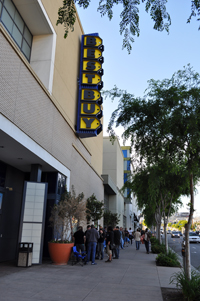
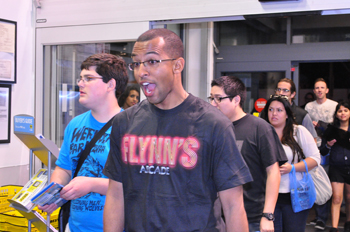
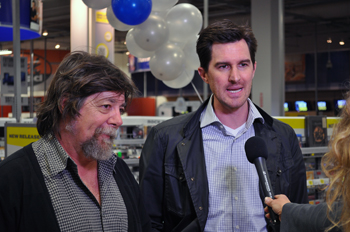
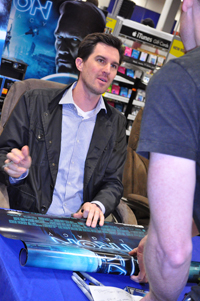
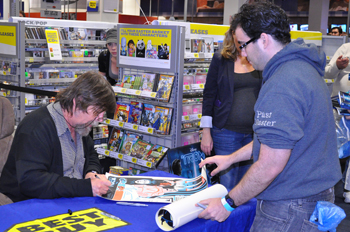
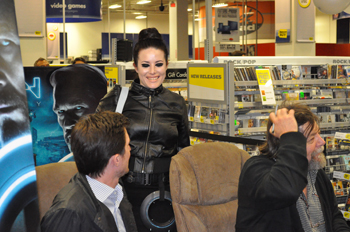
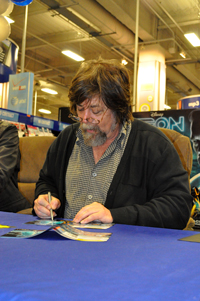
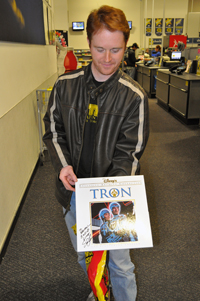
Special thanks to Click Communications, Dre Birskovich, Amelia
McPartlon, Adam Becker, Steven Lisberger and Joseph Kosinski
Photos: © Bill Kallay. All rights reserved.